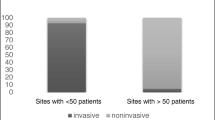Abstract
Background
While domiciliary non-invasive ventilation (NIV) was initially used in the treatment of respiratory failure resulting from chest wall deformity, the main indication is now chronic obstructive pulmonary disease (COPD) with recurrent exacerbations associated with type 2 respiratory failure. A longitudinal study of domiciliary NIV provides insights into the evolution of this treatment in the west of Ireland.
Methods
The cohort of patients receiving new prescriptions for domiciliary NIV from Galway University Hospital from 2000 to 2012 was reviewed using study coordinator chart reviews and telephone follow-ups.
Results
In total, 161 patients were identified. Prescriptions for domiciliary NIV increased from 2 in 2000 to 35 in 2012. The most common indication between 2000 and 2006 was obesity hypoventilation syndrome (OHS), changing to COPD between 2007 and 2012. There were significantly higher mortality rates in COPD and neuromuscular disease at 1- and 3-year follow-up compared to OHS and chest wall disease. Patients with chest wall disease had most survival years (7.33 ± 5.51) following initiation of domiciliary NIV when compared to patients with OHS (5.50 ± 3.70) and COPD (3.03 ± 1.89) and patients with neuromuscular disease (2.50 ± 2.01).
Conclusions
Domiciliary NIV use increased significantly in the West of Ireland from 2000 to 2012. There has been a shift in prescribing toward COPD. Survival rates for COPD on NIV are relatively short in contrast to patients with OHS and chest wall disease. Improved understanding of the benefits of NIV will allow physicians to better determine appropriate and cost-effective use in the future.

Similar content being viewed by others
References
Ward S, Chatwin M, Heather S et al (2005) Randomised controlled trial of non-invasive ventilation (NIV) for nocturnal hypoventilation in neuromuscular and chest wall disease patients with daytime normocapnia. Thorax 60(12):1019–1024
Lloyd-Owen SJ (2005) Patterns of home mechanical ventilation use in Europe: results from the Eurovent survey. Eur Respir J 25(6):1025–1031
Elliott MW (2009) Domiciliary non-invasive ventilation in stable COPD? Thorax 64(7):553–556
Dretzke J, Blissett D, Dave C et al (2015) The cost effectiveness of domiciliary non-invasive ventilation in patients with end-stage chronic obstructive pulmonary disease: a systematic review and economic evaluation. Health Technol Assess 19(81):1–246
Struik FM, Lacasse Y, Goldstein RS et al (2014) Nocturnal non-invasive positive pressure ventilation in stable COPD: a systematic review and individual patient data meta-analysis. Respir Med 108:329–337
Kohnlein T, Windisch W, Kohler D et al (2014) Non-invasive positive pressure ventilation for the treatment of severe stable chronic obstructive pulmonary disease: a prospective multicentre, randomised controlled clinical trial. Lancet Respir Med 2:698–705
Chailleux E, Fauroux B, Binet F et al (1996) Predictors of survival in patients receiving domiciliary oxygen therapy or mechanical ventilation: a 10-year analysis of ANTADIR observatory. Chest 109(3):741–749
Drinker P, Shaw L (1929) An apparatus for the prolonged administration of artificial respiration: a design for adults and children. J Clin Invest. 7(2):229–247
Leger P, Bedicam JM, Cornette A et al (1994) Nasal intermittent positive pressure ventilation. Long-term follow-up in patients with severe chronic respiratory insufficiency. Chest 105(1):100–105
Garner DJ, Berlowitz DJ, Douglas J et al (2013) Home mechanical ventilation in Australia and New Zealand. Eur Respir J 41(1):39–45
Ali S, Kabir Z (2007) Domiciliary non-invasive ventilation and the quality of life outcome of patients suffering from chronic respiratory failure. IMJ. 100(1):336–338
Marti S, Pallero M, Ferrer J et al (2010) Predictors of morality in chest wall disease treated with non-invasive home mechanical ventilation. Respir Med 104:1843–1849
Pinto AC, Evangelista T, Carvalho M et al (1995) Respiratory assistance with a non-invasive ventilator (Bipap) in MND/ALS patients: survival rates in a controlled trial. J Neurol Sci 129:19–26
Wijkstra PJ, Lacasse Y, Guyatt GH et al (2013) Nocturnal non-invasive positive pressure ventilation for stable chronic obstructive pulmonary disease. Cochrane Database Syst Rev 6:CD002878
Midgren B (2010) Home mechanical ventilation in chest wall disease should aim at full correction of PaCO2. Respir Med 104:1765–1766
Piper AJ, Sullivan CE (1996) Effects of long-term nocturnal nasal ventilation on spontaneous breathing during sleep in neuromuscular and chest wall disorders. Eur Respir J 9:1515–1522
Shneerson JM, Simonds AK (2002) Noninvasive ventilation for chest wall and neuromuscular disorders. Eur Respir J 20:480–487
Borel J-C, Pepin J-L, Pison C, Vesin A, Gonzalez-Bermejo J, Court-Fortune I, Timsit J-F (2014) Long-term adherence with non-invasive ventilation improves prognosis in obese COPD patients. Respir J 19:857–865
Windisch W (2008) Impact of home mechanical ventilation on health-related quality of life. Eur Respir J 32:1328–1336
Tissot A, Jaffre S, Gagnadoux F et al (2015) Home non-invasive ventilation fails to improve quality of life in the elderly: Results from a multicenter cohort study. PloS One 10:e0141156
Dreher M, Storre JH, Schmoor C et al (2010) High intensity versus low intensity non-invasive ventilation in patients with stable hypercapnic COPD: a randomised crossover trial. Thorax 65:303–308
Acknowledgments
The authors would like to thank the staff and patients affiliated with the NIV research project. We would also like to acknowledge Professor Patrick Finnegan who initially pioneered and set up the NIV service in Galway University Hospital.
Author information
Authors and Affiliations
Corresponding author
Ethics declarations
Conflict of interest
All authors declare that they have no conflicts of interest in relation to this work.
Ethical approval
All procedures performed in studies involving human participants were in accordance with the ethical standards of the institutional and/or national research committee and with the 1964 Helsinki declaration and its later amendments or comparable ethical standards.
Rights and permissions
About this article
Cite this article
Gouda, P., Chua, J., Langan, D. et al. A decade of domiciliary non-invasive ventilation in the west of Ireland. Ir J Med Sci 186, 505–510 (2017). https://doi.org/10.1007/s11845-016-1516-5
Received:
Accepted:
Published:
Issue Date:
DOI: https://doi.org/10.1007/s11845-016-1516-5




